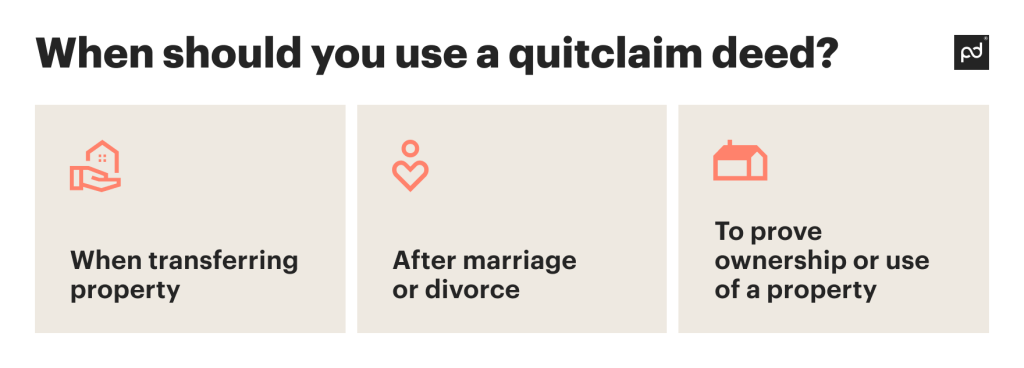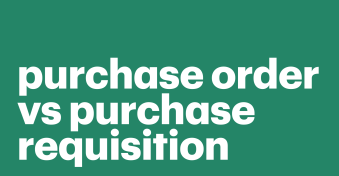A quitclaim deed is an alternative way to transfer property more quickly but with a higher degree of risk attached.
Real estate transactions deal with the transfer of valuable land, so it’s no surprise that they’re subject to a higher degree of formality than regular contracts.
During the sale of a property, you’ll need both parties to sign a deed in the presence of a notary public and encounter several other legal obstacles and documentation hurdles.
A quitclaim deed is another method.
Key takeaways
- A quitclaim deed releases any claim or interest the grantor has in a property, but it doesn’t specify the nature or rights of that interest, nor does it provide any warranty to the grantee.
- A quitclaim deed also doesn’t guarantee the grantor’s actual ownership and simply states that, if ownership exists, those rights are being released.
- Quitclaim deeds are typically considered too risky to transfer property as part of purchase agreements, but they can be helpful for non-sale situations where the grantor and grantee are trusted partners.
- You may hear quitclaim deeds called “quick claim deeds,” as they are faster to complete than a typical warranty deed.
- You can use PandaDoc’s quitclaim template and eSignature functionality to help formalize the transfer of a property title.
What is a quitclaim deed
A quitclaim is a common-law concept that first originated in Medieval England.
Essentially, a person who signs a quitclaim (the grantor) renounces any claim they have to an existing legal right, often to transfer this claim to a grantee.
In property law, the meaning of a quitclaim deed is essentially the same: it allows someone to relinquish their claim to a real estate title and transfer their interest to a third party.
Within a quitclaim deed, you’ll typically find a legal description of the property, details about the individual transferring their interest, the name of the grantee receiving it, the transaction date, and the notarized signatures of both parties.
What does a quitclaim deed do
Quitclaim deeds are a standard method of transferring a property title.
They’re favored for their simplicity and speed, as they don’t require a title search or the extensive documentation you get with a standard warranty deed.
However, you must still follow a strict checklist and procedure for a quitclaim deed to take effect.
How does a quitclaim deed work to be legally binding
To start, you first need to prepare the deed document.
Here, you must identify yourself (the grantor) and the person receiving your interest in the property (the grantee).
You must also include an exact legal description and portrayal of the property, essential for precisely identifying the land.
Finally, the wording of your deed must promise to release or quitclaim your interest in the property to the grantee.
Next, you must sign the deed in the presence of a notary public, i.e., a legal professional who will verify your identity and attest that you signed voluntarily and while of sound mind.
This process doesn’t take long with PandaDoc, as we offer a service for getting documents notarized online.
The grantee doesn’t normally have to sign the quitclaim deed for it to come into effect.
It can, therefore, be considered a ‘unilateral contract,’ with their acceptance demonstrated by their actions after the deed has been delivered.
Why is a quitclaim deed considered “risky”
Essentially, it provides the grantee with the lowest amount of legal protection compared to other deeds.
For example, the process doesn’t include a title search to confirm that the person owns the land.
This means the grantee has no assurance that they’ll receive the full title to it as described in the quitclaim.
What’s a quitclaim deed used for in practice
Due to their inherent risk, quitclaim deeds aren’t considered appropriate for transferring a property purchased by the grantee.
In this case, a warranty guarantee would provide more assurances to a prospective buyer and opportunities for legal recourse should the deed contain any defects.
So, a quitclaim deed should only transfer land between two parties that trust one another.
For example, between family members, business partners, joint property owners, or the executor and beneficiary in a trust.
In the next section, we’ll explore some of the most common use cases for quitclaim deeds in more detail and why using them is sometimes the most desirable property transfer method.
When should you use a quitclaim deed
Whether addressing family transfers, resolving title issues, or clarifying property interests, discerning the appropriate circumstances for a quitclaim deed can significantly impact the efficiency and clarity of real estate transactions.

When transferring property
A quitclaim deed is typically the fastest way to transfer property ownership, which makes it ideal in the following circumstances:
- When giving a gift or inheritance to a trusted party.
- When changing the ownership structure of a business’s assets.
- When transferring property into a trust or estate.
After marriage or divorce
You’ve recently tied the knot, and now you’re ready to merge more than just your lives.
If you want to add your spouse to the property title, a quitclaim deed is the perfect tool.
You can immediately change ownership while avoiding costly legal fees and unnecessary delays.
Likewise, this method can quickly remove a person’s name from a jointly-owned property title, as is often the case in a divorce settlement.
There are risks to this approach, as removing one party’s interest may not alleviate any existing mortgage responsibilities.
So, consulting with a tax professional before signing anything is a good idea.
To prove ownership or use of a property
Sometimes, you might not be transferring ownership but simply need to document your interest in a property.
This could be the case if you’ve been residing on family land without a formal title or if you’ve been using a property for a specific purpose with the owner’s permission.
By having the owner execute a quitclaim deed in your favor, you gain a tangible document affirming your right to use or occupy the property.
How to file a quitclaim deed in 3 steps
1) Find a suitable quitclaim deed form
Technically, you could write a deed on a napkin, but using an online template is much easier (and safer).
2) Complete the form
Describe the property, identify the parties, and attach your assessor’s parcel number. Then, sign it with a PandaDoc notary present.
3) Take it to a registrar
This is to ensure the transaction is publicly recorded.
Does a quitclaim deed give you ownership of a property
A quitclaim deed gives the grantee property ownership insofar as the grantor owned the land when signing the document.
The downside is that quitclaim deeds provide no warranty to the grantee (see contract terminology).
They don’t prove a property title’s ownership or quality, which could be invalid and legally unenforceable.
On top of this, the grantee has very limited legal recourse to hold the grantor responsible for any undisclosed defects in the title.
Ensure all your documents, contracts, and deeds are correct with PandaDoc document management
To wrap up, quitclaim deeds are a valuable tool for transferring property ownership and aren’t beholden to the same bureaucracy you get with warranty deeds.
That doesn’t mean they’re a piece of cake, though. You’re still changing a property title, so the stakes are high if you incorrectly write or file the deed.
If the deed is ever challenged, the grantee could lose their property rights entirely.
So, it’s good practice to use a trusted document management software like PandaDoc.
We have you covered from document creation to storage, with eSignature functionality and online notarization services to ensure your deed is legally binding.
If you’re wondering what one looks like, check out the following quitclaim deed template.
Frequently asked questions
-
A quitclaim deed doesn’t have an expiration date. Once properly executed, notarized, and recorded, it becomes a permanent part of the public record. The quitclaim deed remains valid for as long as the ownership transfer is recognized as legally sound, meaning it can only be overturned if the deed was signed under fraud, duress, or undue influence.
-
The short answer is “Yes”. The concept of ‘quitclaiming’ property rights has been a feature of common law for centuries.
Whether it’s legally enforceable is an entirely different question, so you must ensure your deed is written in precise legal language that identifies the property and parties and is signed in the presence of a notary public.


